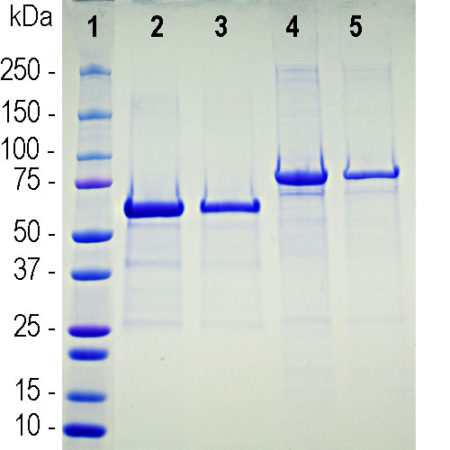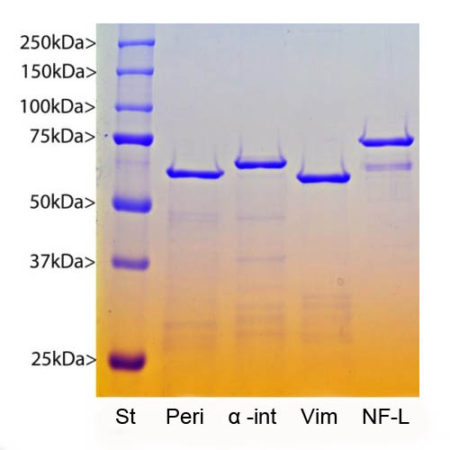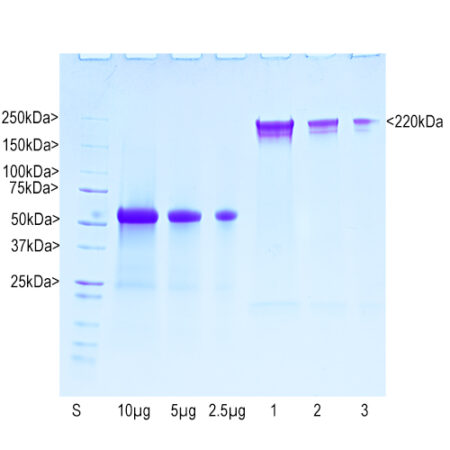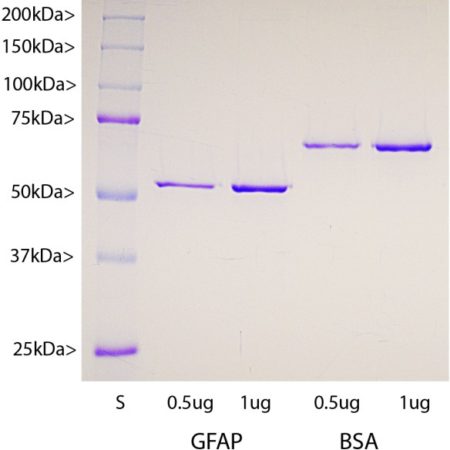GFAP was isolated from bovine spinal cord using the the method of Leung and Liem as far as the 6M urea/hydroxyapatite step (1). The material was then fractionated using a phosphate gradient on DEAE-cellulose in 6M urea, and GFAP rich fractions were concentrated. Lane marked S shows protein molecular weight standards of indicated size. Next three lanes show indicated amounts of BSA standard. Lanes 1, 2 and 3 show purified bovine GFAP, each with half the amount as the previous. There are multiple isotypes of GFAP generated by alternate transcription from a single gene (5), and there are several possible post-translational modifications of the expressed isoforms. As a result, these preparations do not show a single protein band, but several, all of which can be bound with most monoclonal antibodies to GFAP.
Purified Bovine GFAP protein
Cat# Prot-m-GFAP-bov
$300.00 – $2,000.00
| Name: | Purified bovine GFAP |
| Immunogen: | Bovine GFAP isolated from spinal cord |
| HGNC Name: | GFAP |
| UniProt: | Q28115 |
| Molecular Weight: | ~50kDa |
| Host: | Cow |
| Isotype: | |
| Species Cross-Reactivity: | NA |
| RRID: | Pending |
| Format: | 1mg/mL in 6M Urea |
| Applications: | ELISA, western blotting standard |
| Recommended Dilutions: | 1-5µg/mL for SDS-Page |
| Storage: | Store at -20°C |
Glial Fibrillary Acidic Protein (GFAP) is a major protein of the nervous system and is localized in astrocytes, stem cells, Bergmann glia and non-myelinating Schwann cells. It may also be found in retinal Mueller cells in pathological states, and the levels of the protein generally increase in damage and disease states. GFAP assembles to form 10nm or intermediate filaments in the cytoplasm, and these filaments appear to have an important structural role in the cell.
Glial Fibrillary Acidic Protein (GFAP) was discovered by Amico Bignami and coworkers as a major fibrous protein of multiple sclerosis plaques (2). It was subsequently found to be a member of the 10nm or intermediate filament protein family, specifically the intermediate filament protein family Class III, which also includes peripherin, desmin and vimentin. The GFAP protein runs on gels at ~55 kDa protein, usually associated with lower molecule weight bands which are proteolytic fragments and alternate transcripts from the single gene. GFAP is strongly and specifically expressed in astrocytes and certain other astroglia in the central nervous system, in satellite cells in peripheral ganglia, and in non-myelinating Schwann cells in peripheral nerves. In many damage and disease states GFAP expression is heavily upregulated in astrocytes. In addition neural stem cells frequently strongly express GFAP. Antibodies to GFAP are therefore very useful as markers of astrocytic cells and neural stem cells. In addition many types of brain tumor, presumably derived from astrocytic cells, heavily express GFAP. Finally, Alexander’s disease was recently shown to be caused by point mutations in protein coding region of the GFAP gene (3). All forms of Alexander disease are characterized by the presence of Rosenthal fibers, which are GFAP containing cytoplasmic inclusions found in astrocytes. See also reference 4 for some important earlier work. The HGNC name for this protein is GFAP. There are multiple isoforms of GFAP which have slightly different molecular weights and functional properties (5).
1. Leung, C. L. and Liem, R. K. H. Isolation of intermediate filaments. Curr. Prot. Cell Biol. 3:Unit 3.23 doi: 10.1002/0471143030.cb0323s31 (2006).
2. Bignami A, Eng LF, Dahl D, Uyeda CT. Localization of the glial fibrillary acidic protein in astrocytes by immunofluorescence. Brain Res. 43:429-35 1972.
3. Brenner M. et al.. Mutations in GFAP, encoding glial fibrillary acidic protein, are associated with Alexander disease. Nat Genet 27:117-20 2001
4. Liem RKH, Yen SH, Salomon GD and Shelanski ML. Intermediate filaments in nervous tissues. J Cell Biol 79:637-745 (1978).
5. Moeton, M. et al. GFAP isoforms control intermediate filament network dynamics, cell morphology, and focal adhesions Cell Mol Life Sci 73:4101-4120 (2016).
Related products
-

Recombinant ACE2 SARS-CoV2 Binding Domain
$300.00 – $2,000.00Select options This product has multiple variants. The options may be chosen on the product page -

Recombinant Human NF-L
$300.00 – $2,000.00
Cat# PROT-r-NF-LSelect options This product has multiple variants. The options may be chosen on the product page -

Purified Bovine Neurofilament NF-H
$300.00 – $2,000.00
Prot-m-NF-HSelect options This product has multiple variants. The options may be chosen on the product page -

Recombinant Human GFAP Protein
$300.00 – $2,000.00
Cat# Prot-r-GFAPSelect options This product has multiple variants. The options may be chosen on the product page
Contact info
EnCor Biotechnology Inc.
4949 SW 41st Boulevard, Ste 40
Gainesville
Florida 32608 USA
Phone: (352) 372 7022
Fax: (352) 372 7066
E-mail: admin@encorbio.com



